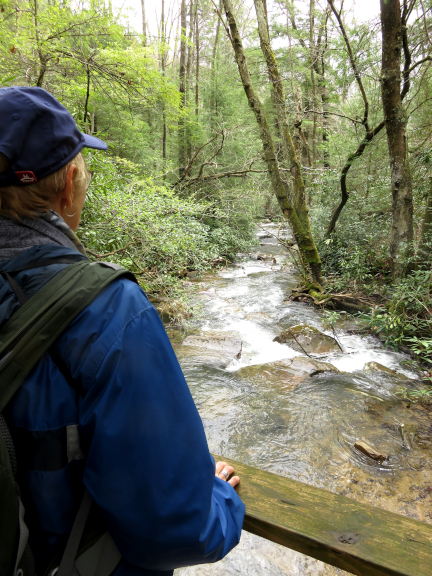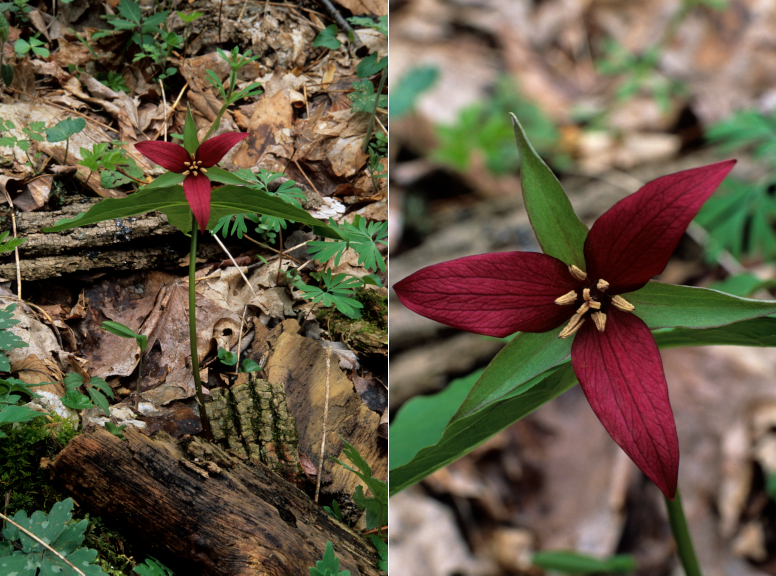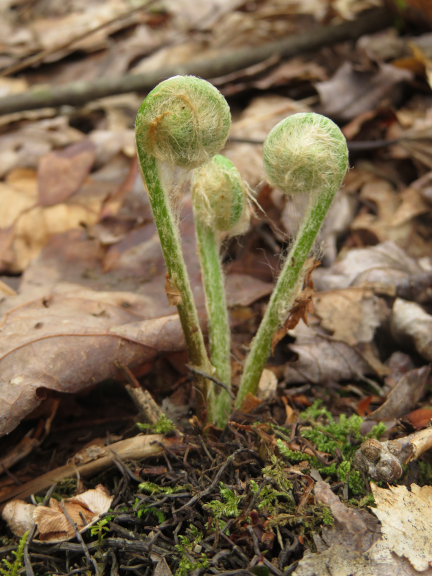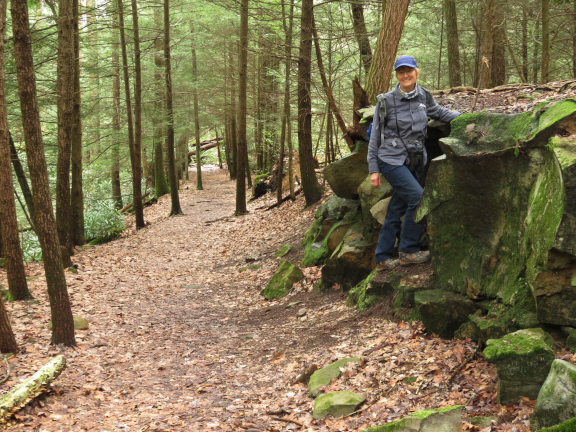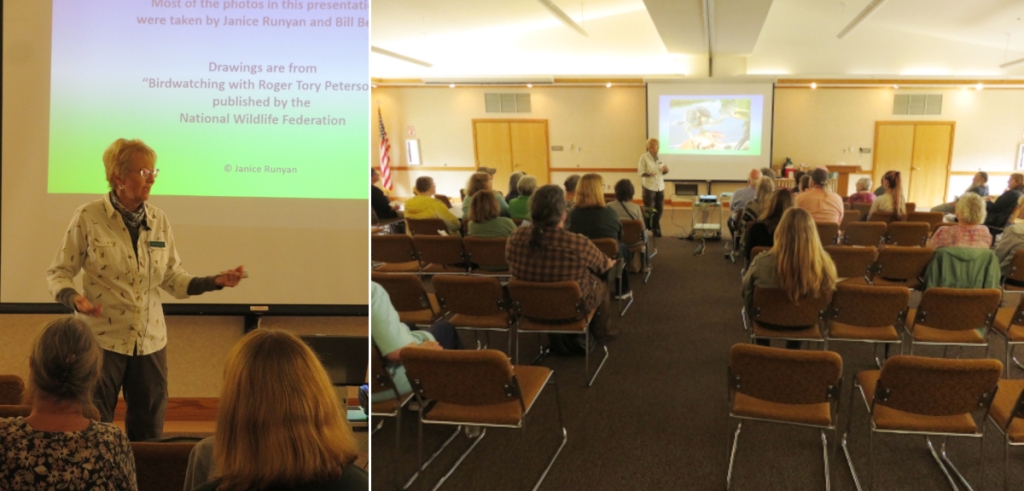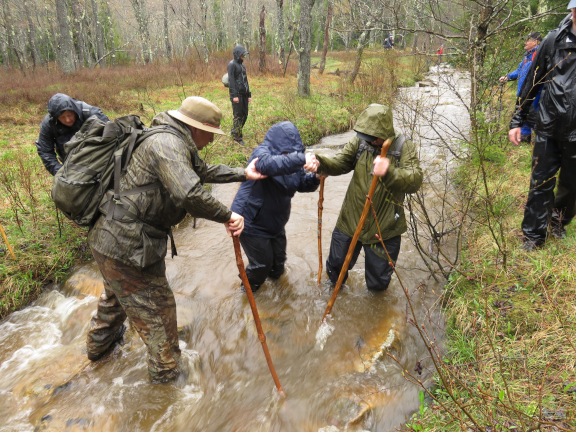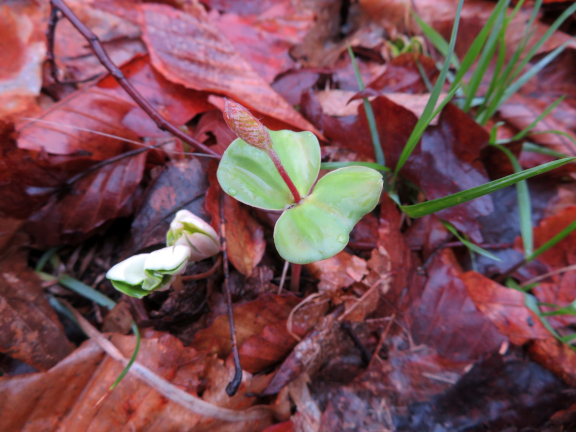Most years on our way to the WV Wildflower Pilgrimage at Blackwater Falls State Park, Jan and I stop at the Hemlock Hiking Trail in Coopers Rock State Forest to warm up to our weekend of outdoor activity. This year was no different.
When Jan chose her coat, she didn’t realize that she had stumbled onto the color of the day!
Immediately surrounded by lots of birds we hadn’t seen or heard in months, we descended the trail through a wooded hillside down to Lick Run. This beautiful stream often runs high, but a sturdy bridge makes it possible to cross without boots getting soaked.
By the stream it was difficult to hear the spring songs of the migrating birds so we concentrated on plants for a while. Turning left, the first part of the trail is always a great place to compare several kinds of violets the West Virginia woods offer.
Although we didn’t see the Round-leaved Violets flowering at this time, their attractive leaves were all along the trail. This photo was taken at another visit in March.
The upper part of the trail traversed deciduous woodlands filled with singing warblers. The understory of those trees offered singing thrushes, wildflowers and other nature.

The lower, return part of the Hemlock Hiking Trail loop goes along Little Laurel Run and follows a path lined with majestic and smaller Eastern Hemlock trees.
The stream! The geology! The mosses! Everywhere there were wonderful things to see, hear, smell and touch!
Refreshed with memories of wonderful birdsongs and plants, we returned to our car and continued on to Blackwater Falls State Park and the WV Wildflower Pilgrimage.
Jan’s “Birding Essentials” program on Thursday afternoon was well attended and was a great start to the 4-day Wildflower Pilgrimage.
On Thursday night I presented a program about “Northern Saw-whet Owl Studies” to all the Wildflower Pilgrimage attendees.
Friday was WET! My Dolly Sods Wilderness Hike was quite an experience. I have hiked Dolly Sods by myself when the streams were incredibly high and dangerous, but not as a leader of a group of some seasoned and not-so-seasoned hikers. I decided that, although the water was high, it wasn’t so high as to be considered life-threatening, although a few of the hikers might disagree. We had 19 stream crossings, but usually they only require stepping on one or two exposed rocks to get across. The crossing of Red Creek is usually the only one we sometimes have to wade with bare feet or sandals. But constant rain made this quite a different trip.
Once across, we continued on our way through the wilderness to our mid-way lunch spot.
At lunch the heavens opened and it rained, and rained, and rained, causing the streams to quickly rise a LOT! And the remaining 17 stream crossings, which are usually dry, easy steps, became increasingly more difficult.
Due to the constant rain, I couldn’t take any more photos. We had to wade the stream 16 more times. (No, there just isn’t another easier way out from that particular area.) The hike took considerably longer than usual and we knew we would be late getting back for supper, showers and the evening meeting.
Then, to add to our delay, there was a large tree across the road out of the wilderness and we had to make a significant detour.
We got back 3 hours later than we should have. However, I still believe: The worst day on Dolly Sods is better than the best day anywhere else.
Jan’s tour on Friday to Cranesville Swamp was less eventful and more Nature-oriented. Although her group didn’t experience a deluge, they did have a fairly constant light rain, preventing her from taking many photos.
The West Virginia part of Cranesville Swamp is an acidic bog which has some very unusual plants.
Every year Jan wonders if she will be able to find the Goldthread again, and so far the area has not disappointed. It was a little early to find the insectivorous Sundew plants at the edges of the water.
When the rain was lighter, birder Kathy Kern helped the pilgrims identify birds they were hearing. Part of the far end of the boardwalk was under several inches of water, which kept some of the pilgrims from going any farther. After reaching the Hemlock grove beyond the end of the boardwalk, all but 2 pilgrims turned back to avoid even worse mud. The father/daughter team that went all the way around arrived back at the beginning of the boardwalk before those who had turned around.
The field trip ended with a short stop at the Maryland end of Cranesville Swamp to look out over the alkaline wetland fen.
On Friday night Jan presented, “Allegheny Front Migration Observatory: Over 50 Years of Bird Migration and Sunrises“, to all the Wildflower Pilgrimage attendees.
On Saturday, Jan and I led the tour called, “Canaan Valley National Wildlife Refuge Hike“. Like Friday, it was rainy, but the showers were more intermittent.
Our walk on the Beall Tract of the Canaan Valley National Wildlife Refuge was through areas of woodlands and large open wetland-meadows. Along the trail through a woodland part we encountered a mystery plant.
We continued to see this mystery plant each time the trail traversed a woodland. After managing to find the mystery plant in different stages of growth, we determined that these plants were American Beech tree seedlings, shortly after germination.
There were many wildflowers along our route on the Beall Trail North and then after lunch along the Idleman’s Run Trail.
We saw several kinds of violets including Long-spurred Violets (Viola rostrata).
The cool, wet weather didn’t dampen the interest of our National Wildlife Refuge explorers.
The last creature we found and talked about was a Red Eft, which is the juvenile, terrestrial stage of the Eastern Red-spotted Newt Salamander.
On Saturday night at the banquet and at Sunday morning activities, we enjoyed sharing “rain stories” with people who had gone on other trips (the trips eastward into the “rain shadow” of the mountains were the driest), and catching up with many friends from past pilgrimages and other Nature events in “Wonderful West Virginia”.
Since the beginning of the West Virginia Wildflower Pilgrimage, we have had freezing cold, stifling hot, very wet, and amazingly beautiful weekends. However, there is a constant that applies to every Pilgrimage — they are all educational and terrifically fun!

